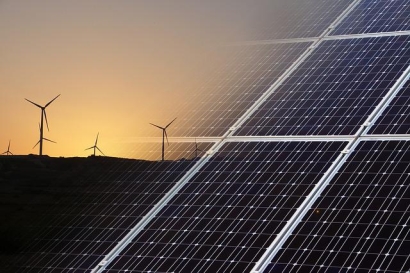
According to the latest issue of FERC's monthly "Energy Infrastructure Update" (with data through November 30, 2022), "high probability" additions by solar to U.S. generating capacity between December 2022 and November 2025 will total 72,809 megawatts (MW). FERC foresees no solar capacity retirements during that time. Such growth would nearly double solar's share of total available installed generating capacity, increasing it from 78,880-MW to 151,690-MW. (And this does not include small-scale, distributed solar capacity. [1])
In addition, wind generating capacity would grow substantially - by 16,955-MW - with just 140-MW of retirements. Hydropower is also expected to increase by 819-MW with 46-MW of retirements.
While FERC projects 17,260-MW of "high probability" additions by natural gas, that capacity would be almost entirely offset by 16,954-MW of retirements. Similarly, an expected increase of 2,200-MW in new nuclear capacity would be completely negated by 2,323-MW in retirements. FERC foresees no new coal capacity over the next three years but does anticipate 17,385-MW of retirements as well as a net decrease of 1,677-MW in oil generating capacity..
Between "high probability" additions and retirements among all energy sources, FERC projects a net increase of 71,391-MW in installed U.S. generating capacity. In effect, new solar would account for the overall net increase in the nation's total capacity while new wind capacity would roughly displace the net decreases in fossil fuel and nuclear capacity.
If FERC's data become reality, by November 2025, solar and wind will be nearly equal in their shares of U.S. generating capacity -- 11.41% and 12.02% respectively. The combination of all renewables (i.e., including hydropower, biomass, and geothermal) will account for almost one-third (32.54%) of U.S. generating capacity - up from 27.19% today. Meanwhile, natural gas' share will drop from 44.15% to 41.80% while coal falls from 17.34% to 15.10% and nuclear from 8.14% to 7.69%. Contributions by oil and biomass would also fall.
Beyond "high probability" additions, FERC also provides data on "all additions" for each energy source that may be in the three-year pipeline. Solar dominates with 201,637-MW, followed by 67,950-MW for wind. By comparison, natural gas has only 33,547-MW. Hydropower accounts for another 12,400-MW. Consequently, it is conceivable that solar's expanding share of U.S. generating capacity over the next three years could be even larger.
The trend lines during the first eleven months of 2022 suggest the higher forecasts for solar and wind may well prove accurate. Through the end of November, renewable energy sources accounted for 72.83% of all new capacity additions in 2022 with solar in the lead (36.53%), followed by wind (35.68%) - each comfortably surpassing natural gas (27.02%). In the month of November alone, renewables were 98.11% of all new capacity additions with solar again taking the lead (727-MW), followed by wind (665-MW), and only 27-MW of new gas.
As 2022 drew to a close, the share of the nation's generating capacity provided by utility-scale solar and wind totaled 17.63% (solar - 6.27%, wind - 11.36%). That surpassed the installed generating capacity of coal (17.34%) and greatly exceeded that of either nuclear power (8.14%) or oil (3.01%).[2]
"The combined generating capacity of solar and wind is now greater than either coal or nuclear power," noted the SUN DAY Campaign's executive director Ken Bossong. "Moreover, if the current trajectory persists or accelerates, generating capacity by the mix of all renewables should overtake that of natural gas before 2030 and possibly much sooner."
NOTES
[1] FERC generally only reports data for utility-scale facilities (i.e., those rated 1-MW or greater) and therefore its data do not reflect the capacity of distributed renewables, notably rooftop solar PV which - according to the EIA - accounts for almost 30% of the nation's electrical generation by solar. That would suggest that the total of distributed and utility-scale solar capacity combined is significantly more than the solar capacity of 6.27% reported by FERC for the first 11 months of 2022 and is perhaps closer to 8.5% - 9.0%.
[2] Capacity is not the same as actual generation. Capacity factors for nuclear power and fossil fuels tend to be higher than those for most renewables. Thus, in its most recent "Electric Power Monthly" report, the U.S. Energy Information Administration (EIA) reported that renewables accounted for 22.6% of the nation's total electrical generation in the first 10 months of 2022 - that is, somewhat less than what FERC reported was their share (27.0%) of installed generating capacity for the same period.

